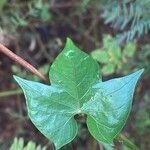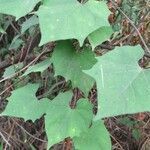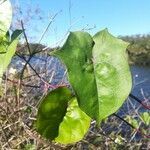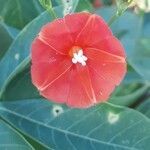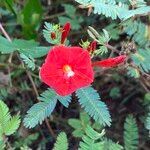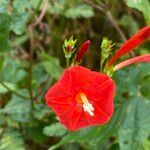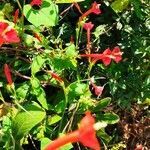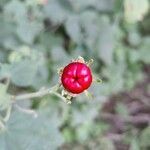Annual; stems twining, 2–5 m. long, glabrous or sparsely pilose.. Leaf-blade ovate to orbicular in outline, 3–15 cm. long, 3–10 cm. wide, acuminate and mucronulate at the apex, cordate at the base, entire or 3-lobed; margin entire, angulate, or dentate; petiole 3–12 cm. long.. Inflorescences lateral or terminal, few-to several-flowered, 10–35 cm. long; peduncle 3–20 cm. long; pedicels erect, 0.5–5 cm. long, enlarging in fruit.. Sepals oblong, 2–3 mm. long; apex obtuse or truncate, with an awn 2–4 mm. long.. Corolla scarlet, glabrous; limb salver-shaped, 2–2.5 cm. in diameter; tube 2.8–4 cm. long, narrowed below, very slightly curved.. Stamens and style exserted 8 mm.. Capsule globose, 5–7 mm. in diameter.. Seeds black, 3.5–4 mm. long, densely pubescent.
Vines; stems slender and herbaceous, annuals, glabrous to sparsely pubescent. Leaves ovate to suborbicular, 2-15 cm long, entire, dentate, trilobate or rarely with 5 or 7 lobes, basally cordate, acute to acuminate apically, glabrous or re-motely pubescent. Flowers in few-to several-flowered cymes or solitary; sepals oblong to elliptic, 1.5-3 mm long, apically obtuse or truncate, the outer sepals with a 1.6-6 mm long subterminal arista, glabrous; corollas red or red-yellow, 2.5-4.5 cm long, the tube 1-2 mm in diameter, the limb 1.8-2.5 cm in diameter. Fruits capsular, subglobose, 6-8 mm in diameter; seeds dark brown or black, pyriform, with usually 2 lines of short dark trichomes on the dorsal face.
Leaf lamina ovate to circular in outline, 3–15 × 3–10 cm., acuminate and mucronulate at the apex, cordate at the base, the margin entire, angular, coarsely dentate or obscurely to deeply 3-lobed, mostly glabrous; petiole 3–12 cm. long, glabrous or sparsely pilose.
Inflorescences lateral or terminal, few to several flowered, 10–35 cm. long, peduncle 3–20 cm. long, terete or angular, glabrous or pubescent; pedicels erect, 0·5–5 cm. long, enlarging in fruit; bracts minute, triangular, mucronulate.
Corolla salver-shaped, scarlet glabrous; tube 2·8–4 cm. long, narrowed below, very slightly curved; limb 2–2·5 cm. in diam.
Stems twining, 2–5 m. long, terete or slightly angular, often contorted, glabrous or sparsely pilose.
Sepals oblong, 2–3 mm. long with apex broadly obtuse or truncate, with an awn 2–4 mm. long.
Annual twiner with brilliant scarlet tubular salver-shaped
Stamens and style exserted 8 mm.
Seeds black, densely pubescent.
Capsule globose, glabrous.
Ornamental annual species.
A creeping herb.
